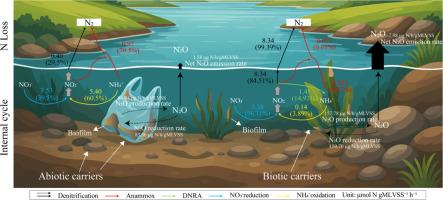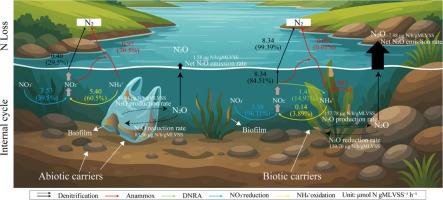淡水湖非生物和生物载体生物膜氮转化和N₂O排放模式:15N同位素示踪研究
IF 12.4
1区 环境科学与生态学
Q1 ENGINEERING, ENVIRONMENTAL
引用次数: 0
摘要
湖泊生物膜在氮循环中起关键作用;然而,载体类型对其氮转化过程的影响尚不清楚。在这项研究中,我们采用15N同位素示踪、选择性抑制实验和微生物群落分析来研究在生物(水生植物)和非生物(岩石和塑料)载体上形成的生物膜中氧化亚氮(N2O)的发射模式。结果表明,生物载体生物膜主要通过反硝化作用产生NO2-,贡献了99.39%的氮转化,而非生物载体生物膜主要通过硝化作用产生NO2-。此外,生物载体生物膜中的氮损失主要归因于反硝化作用,而在非生物载体生物膜中,厌氧氨氧化(anammox)作用占氮损失的70.5%。环境参数,特别是温度和氧化还原电位,显著调节两种生物膜类型中的氮转化过程。两种生物膜的硝化相关N2O产量差异不显著,生物载体生物膜的反硝化相关N₂O电位显著高于生物载体生物膜,其N₂O产量(157.78 vs 84.94 μg N/h/gMLVSS)和还原率(150.70 vs 83.36 μg N/h/gMLVSS)更高,导致净N₂O排放量增加。微生物群落分析表明,非生物载体生物膜具有较高的氯氟菌和达达菌相对丰度,且具有较强的亚硝酸盐氧化和还原活性。这些发现为研究依赖载体的氮循环机制提供了新的见解,并对湖泊生态系统N2O排放的管理具有重要意义。本文章由计算机程序翻译,如有差异,请以英文原文为准。


Insights into freshwater lake abiotic and biotic carrier biofilm nitrogen transformation and N₂O emission patterns: A 15N isotope tracing study
Lake biofilms play pivotal roles in nitrogen cycling; however, the influence of carrier type on their nitrogen transformation processes remains inadequately understood. In this study, we employed 15N isotope tracing, selective inhibition experiments, and microbial community analysis to investigate nitrous oxide (N2O) emission patterns in biofilms formed on biotic (hydrophyte) and abiotic (rocks and plastics) carriers. Our results revealed that biotic carrier biofilms predominantly generated NO2- via denitrification, contributing 99.39 % of nitrogen transformation, whereas abiotic carrier biofilms primarily produced NO2- through nitrification. Moreover, nitrogen loss in biotic carrier biofilms was mainly attributed to denitrification, while in abiotic carrier biofilms, anaerobic ammonium oxidation (anammox) accounted for 70.5 % of nitrogen loss. Environmental parameters, particularly temperature and oxidation–reduction potential, significantly modulated nitrogen transformation processes in both biofilm types. Nitrification-related N2O production showed no significant difference between the two biofilm types, denitrification-related N₂O potentials were substantially higher in biotic carrier biofilms, with greater N₂O production (157.78 vs 84.94 μg N/h/gMLVSS) and reduction rates (150.70 vs 83.36 μg N/h/gMLVSS), resulting in increased net N₂O emissions. Microbial community analysis indicated that abiotic carrier biofilms harbored higher relative abundances of Chloroflexi and Dadabacteria, whereas abiotic carrier biofilms could show enhanced nitrite oxidation and nitrate reduction activities. These findings offer novel insights into carrier-dependent nitrogen cycling mechanisms and bear significant implications for managing N2O emissions from lake ecosystems.
求助全文
通过发布文献求助,成功后即可免费获取论文全文。
去求助
来源期刊

Water Research
环境科学-工程:环境
CiteScore
20.80
自引率
9.40%
发文量
1307
审稿时长
38 days
期刊介绍:
Water Research, along with its open access companion journal Water Research X, serves as a platform for publishing original research papers covering various aspects of the science and technology related to the anthropogenic water cycle, water quality, and its management worldwide. The audience targeted by the journal comprises biologists, chemical engineers, chemists, civil engineers, environmental engineers, limnologists, and microbiologists. The scope of the journal include:
•Treatment processes for water and wastewaters (municipal, agricultural, industrial, and on-site treatment), including resource recovery and residuals management;
•Urban hydrology including sewer systems, stormwater management, and green infrastructure;
•Drinking water treatment and distribution;
•Potable and non-potable water reuse;
•Sanitation, public health, and risk assessment;
•Anaerobic digestion, solid and hazardous waste management, including source characterization and the effects and control of leachates and gaseous emissions;
•Contaminants (chemical, microbial, anthropogenic particles such as nanoparticles or microplastics) and related water quality sensing, monitoring, fate, and assessment;
•Anthropogenic impacts on inland, tidal, coastal and urban waters, focusing on surface and ground waters, and point and non-point sources of pollution;
•Environmental restoration, linked to surface water, groundwater and groundwater remediation;
•Analysis of the interfaces between sediments and water, and between water and atmosphere, focusing specifically on anthropogenic impacts;
•Mathematical modelling, systems analysis, machine learning, and beneficial use of big data related to the anthropogenic water cycle;
•Socio-economic, policy, and regulations studies.
 求助内容:
求助内容: 应助结果提醒方式:
应助结果提醒方式:


